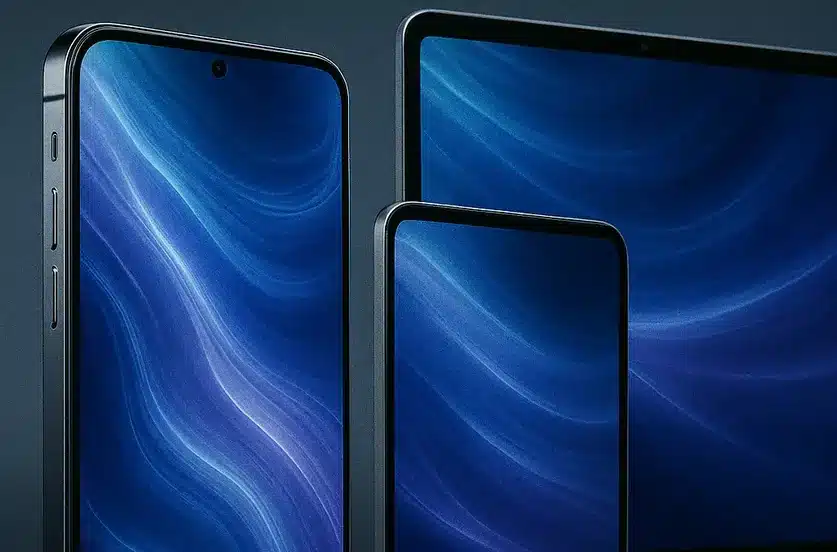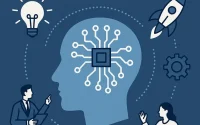Apple’s Worldwide Developers Conference (WWDC) 2025 has introduced a sweeping visual overhaul to its entire ecosystem with the new “Liquid Glass” design language. This transparent, reflective aesthetic now unifies all Apple operating systems under version number 26, marking a significant departure from previous design approaches. The event showcased substantial updates across iOS, iPadOS, macOS, watchOS, tvOS, and visionOS, with particular emphasis on iPad functionality that blurs the line between tablets and traditional computers.
The most striking aspect of this year’s WWDC was Apple’s strategic pivot away from heavily promoting AI features (with only two mentions of Siri throughout the 90-minute keynote) and instead focusing on visual redesigns and functional improvements that users have requested for years. This approach appears to be Apple’s response to the AI-dominated landscape where competitors like Google and OpenAI have been making headlines.
The Unified Version 26 Approach
In a move reminiscent of Samsung’s 2020 decision to align product numbers with calendar years, Apple has standardized all its operating systems under version 26, replacing the previous numbering system (iOS 19, iPadOS 19, tvOS 19, macOS 16, watchOS 12, and visionOS 3). This unified approach simplifies the ecosystem and creates a more cohesive brand identity across all Apple platforms.
Understanding the “Liquid Glass” Design Philosophy
The new Liquid Glass design treats every window, dialog box, icon, and sidebar as a piece of physical glass with transparency effects that reveal content beneath. This approach extends even to lock screen elements and fonts, creating a consistent visual language throughout the ecosystem. While visually striking, some implementations raise concerns about readability, particularly when text appears over complex backgrounds that are half light and half dark.
iOS 26: Transparency and Functionality Updates
Redesigned Camera App After a Decade
For the first time in over ten years, Apple has completely redesigned the iPhone camera app with a simplified interface focused on just photo and video buttons alongside the shutter. Additional modes are now hidden behind a swipe gesture, while frame rate and resolution settings require tapping a small button in the corner. This design choice suggests Apple’s data indicates most users rarely change these settings, though power users may need time to adjust to the new layout.
“The swipe up to reveal many settings means most people will never see options like the live photos toggle,” the presenter notes, highlighting how Apple’s design decisions are driven by user behavior data.
Communication App Enhancements
iOS 26 brings significant updates to communication apps:
- FaceTime: A new landing page provides quick access to favorite contacts
- Phone App: Unified interface combining voicemail, missed calls, and contacts
- Call Screening: Automatically screens unknown numbers by answering and transcribing before ringing your phone
- Hold Assist: Waits on hold for you and rings when a human representative is available
iMessage Improvements
The messaging experience receives several quality-of-life improvements:
- Native polls within conversations
- Typing indicators in group chats that show which specific person is typing
- Custom background images for individual message threads
Live Translation Features
Perhaps the most AI-focused addition to iOS 26 is the comprehensive live translation capability now integrated into FaceTime, Messages, and the Phone app. This feature enables real-time translation during calls, allowing participants to speak in their native languages while hearing translations in their preferred language. Though the presenter notes some latency issues, the functionality represents a significant step forward in breaking down language barriers.
Learn more about the evolution of real-time translation technology
iPadOS 26: The Game-Changing Update
Mac-Like Multitasking Finally Arrives
The most substantial update of WWDC 2025 is undoubtedly iPadOS 26, which introduces true desktop-class multitasking capabilities:
- Window resizing via a corner handle that transforms apps into floating windows
- Free arrangement of multiple windows side by side
- Mac-style window controls (“stoplights”) for minimizing or changing window shapes
- A traditional Mac menu bar with File, Edit, View, and Help options
- Redesigned cursor that behaves more like a traditional mouse pointer rather than the previous “floating blob”
“Every iPad Pro video for the last six years has always said the same thing: it’s great, amazing hardware, very powerful, but it’s still an iPad with limitations,” the presenter explains. “With this update, I feel like they use the word ‘game changer,’ which they use all the time, but I actually feel like this genuinely fits the bill.”
Enhanced File Management and Background Activities
iPadOS 26 also brings significant improvements to file handling and background processes:
- Redesigned Files app with Mac Finder-like sorting options
- Downloads folder in the dock
- Audio input selector for media apps
- Background activities that continue even when an app is closed (like Final Cut Pro exports)
These changes represent a fundamental shift in Apple’s approach to the iPad, moving it much closer to laptop functionality while maintaining its touch-first interface advantages.
macOS 26 Tahoe: Clarity and Productivity
Embracing Transparency
macOS 26, codenamed “Tahoe,” fully embraces the Liquid Glass design language with clear elements throughout the interface:
- Transparent Control Center with redesigned buttons
- Clear widgets and dock options
- Completely transparent menu bar that makes the screen feel larger
While some of these design choices may take time to adjust to, they create a cohesive visual experience across the Apple ecosystem.
Spotlight Enhancements Challenge Third-Party Tools
The most significant functional update to macOS is the completely redesigned Spotlight search, which now incorporates many features previously only available in third-party productivity tools like Raycast:
- Improved file search capabilities
- Series shortcut searches
- Ability to execute app actions directly from the keyboard without opening applications
- Command string execution without mouse interaction
“This is what we call in the industry getting Sherlocked,” the presenter notes, referring to Apple’s history of incorporating popular third-party functionality into its operating systems. While the new Spotlight doesn’t yet match all of Raycast’s capabilities (like AI integration), it represents a major step forward for built-in productivity tools.
watchOS 26: Gesture Controls and Workout Motivation
Intuitive Wrist Flick Gesture
watchOS 26 introduces a simple yet effective wrist flick gesture for dismissing notifications, alarms, and phone calls without touching the screen. This natural interaction method promises to become a frequently used feature for Apple Watch users.
Workout Buddy for Exercise Motivation
The new Workout Buddy feature provides customizable, high-energy voice coaching during exercise sessions. Similar to Spotify DJ but for workouts, it offers motivational cues and relevant statistics like heart rate and mile splits at opportune moments during your activity. However, the presenter notes that group fitness challenges—a frequently requested feature—remain absent.
visionOS 26: Spatial Computing Refinements
Persistent Widgets and Window Placement
visionOS 26 introduces persistent widgets that can be pinned to specific locations in your space:
- Customizable size, depth, and color
- Options including clocks, weather widgets, and picture frames
- Convincing location pinning with reflectivity and depth effects
Additionally, visionOS now remembers window placement through reboots, addressing one of the presenter’s “biggest complaints” from the original visionOS review.
Enhanced Personas and Controller Support
Other notable visionOS improvements include:
- More photorealistic personas with less “cartoon ghosty” appearance
- PlayStation VR2 Sense controller support for precise game controls
- New Jupiter environment that places users on one of Jupiter’s moons
- Native 360-degree video support for content from GoPro, Insta360, and Canon cameras
Apple’s AI Strategy: Integration Over Promotion
Subtle AI Implementation
Despite the tech industry’s current focus on artificial intelligence, Apple took a notably different approach at WWDC 2025. Rather than heavily promoting AI features, Apple has integrated AI capabilities throughout its ecosystem without explicitly branding them as such. The presenter notes that the word “Siri” was mentioned only twice during the entire 90-minute keynote.
Developer Access to On-Device Models
Apple is making its foundational AI models available to developers, enabling them to build AI features into their apps that leverage on-device processing. While these models may not be “the best in the world,” their on-device nature offers advantages in speed, privacy, and offline functionality.
Delayed LLM Siri Upgrade
The anticipated major upgrade to Siri using large language models (LLMs) was briefly addressed at the beginning of the keynote with a statement indicating it “required more time to reach our high quality bar” and would be shared “in the coming year.” This suggests Apple is prioritizing quality over rushing to market with an unpolished AI assistant.
Read more about Apple’s cautious approach to AI development
Related Post: Explore Top Jobs on WhatJobs
Looking to work with cutting-edge technology like Apple’s new operating systems? From iOS developers to UX designers specializing in transparent interfaces, the tech industry needs skilled professionals.
Search thousands of technology career opportunities on WhatJobs
The Future of Apple’s Software Ecosystem
Finding Balance Between Visual Design and Functionality
As Apple continues to refine its Liquid Glass design language, the company will need to carefully balance visual appeal with practical usability. The presenter raises legitimate concerns about readability with transparent elements, particularly when text appears over complex backgrounds. How Apple addresses these concerns in future updates will be crucial to user acceptance of the new design direction.
iPad’s Evolving Identity
With iPadOS 26, Apple has taken a significant step toward positioning the iPad—especially the iPad Pro—as a legitimate laptop alternative. This raises interesting questions about the future of the Mac lineup and how Apple will continue to differentiate its product categories. As the iPad gains more Mac-like capabilities, Apple may need to find new ways to justify the existence of both platforms.
Apple’s AI Timeline
While competitors race to implement and promote AI features, Apple’s more measured approach reflects its traditional focus on polished, integrated experiences rather than being first to market. The delay of the major Siri upgrade to 2026 suggests Apple is taking the time to ensure its AI offerings meet its standards for quality and integration. This patience may ultimately result in more useful AI features, even if they arrive later than competitors’ offerings.
FAQ: WWDC 2025 Apple Software Updates
What is the “Liquid Glass” design in Apple’s WWDC 2025 software updates?
Liquid Glass is Apple’s new design language introduced at WWDC 2025 that treats interface elements like physical pieces of glass with transparency effects. This design approach creates windows, dialog boxes, icons, and sidebars that appear transparent to content beneath them, creating a unified visual aesthetic across all Apple platforms. The Liquid Glass design is most noticeable in macOS 26 Tahoe and iOS 26, where even the lock screen clock and some fonts appear clear and transparent, adapting to what’s behind them.
How has Apple changed the version numbering for its operating systems at WWDC 2025?
At WWDC 2025, Apple unified all its operating system version numbers to simplify their ecosystem. Instead of having separate version numbers like iOS 19, iPadOS 19, tvOS 19, macOS 16, watchOS 12, and visionOS 3, Apple has standardized everything as version 26 across all platforms. This approach, similar to what Samsung did with their phones in 2020, creates consistency across the ecosystem and aligns with the new unified Liquid Glass design language that now appears on all Apple devices.
What major changes did Apple announce for iPadOS 26 at WWDC 2025?
iPadOS 26 received what many consider the most significant update at WWDC 2025, introducing true desktop-class multitasking capabilities. The update allows users to resize apps into floating windows using a corner handle, arrange multiple windows side by side, and control windows with Mac-style “stoplights” in the corner of each window. iPadOS 26 also adds a Mac-like menu bar with File, Edit, and View options, a redesigned cursor that behaves more like a traditional mouse, an enhanced Files app with better sorting options, and background activities that continue even when apps are closed.
How is Apple approaching AI features in its WWDC 2025 software updates?
Apple’s approach to AI at WWDC 2025 was notably restrained, with the word “Siri” mentioned only twice during the entire 90-minute keynote. Rather than heavily promoting AI features, Apple has integrated AI capabilities throughout its ecosystem without explicitly branding them as such. The company is making its foundational AI models available to developers for on-device processing, offering advantages in speed, privacy, and offline functionality. Apple also announced that the anticipated major upgrade to Siri using large language models has been delayed to 2026 to “reach our high quality bar,” indicating the company is prioritizing quality over rushing AI features to market.




